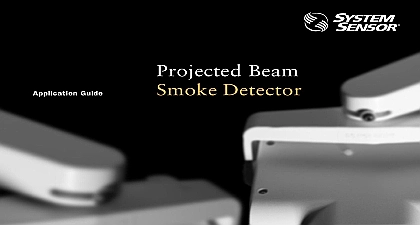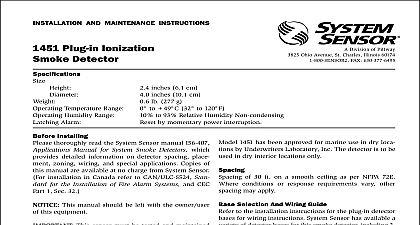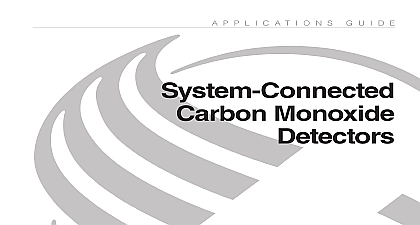System Sensor special projected beam s detectors

File Preview
Click below to download for free
Click below to download for free
File Data
| Name | system-sensor-special-projected-beam-s-detectors-5426809731.pdf |
|---|---|
| Type | |
| Size | 1019.34 KB |
| Downloads |
Text Preview
INSTALLATION AND MAINTENANCE INSTRUCTIONS Projected Beam Type Detector SENSOR Division of Pittway 3825 Ohio Avenue St Charles Illinois 60174 FAX 630 377 6495 Time Condition Features Angle to 330 Feet 5 Total Obscuration or 5 Total Obscuration Seconds Max Seconds Max or More Obscuration Initial Alignment limit reached service needed Filters ALARM NO ALARM Alarm Reset Switch Test and Reset Switch Capability with RTS451 Test Station with Magnet Operation Aid Trouble Output Local LED red Output Local LED yellow LED flashing green Bar Graph 4 red LEDs C to 55 cid 176 C F to 131 cid 176 F RH Noncondensing lbs 663 g 1.3 lbs 598 g or Wall Separate Mounting Brackets Provided with Attached Cable 30 cid 176 Horizontal 60 cid 176 Vertical 90 cid 176 Horizontal 60 cid 176 Vertical Receiver Ripple Voltage 24 VDC to 32 VDC volts Peak to peak Surge at 30 VAC DC Seconds Max Max Max Max Max Contacts Time Time after 5 min reset 1 Minute Maximum Loss Transmitter Ripple Voltage 24 VDC to 32 VDC volts Peak to Peak Max Memory for 5 Minute Minimum Manuals Online Installing thoroughly read this manual and applicable sections System Sensor Manual I56 506 Guide for Proper Use of Beam Detectors Copies of this manual are avail from System Sensor When installing in Canada ref the Standard for Installation of Fire Alarm Systems Description Sensor Model 6424 A is a long range projected smoke detector designed to provide open area protec It is to be used with UL listed separately supplied 4 wire control panels only The detector consists of separate transmitter and receiver Smoke entering the between the transmitter and receiver causes an obscu in signal at the receiver When the obscuration one of two predetermined thresholds chosen with switch in the receiver the detector generates an alarm Complete blockage of the beam causes a trouble sig to avoid false alarms Slow changes in obscuration due a build up of dirt or dust on the lens of the detector are for by a microcontroller which continuously the signal strength and periodically updates the and trouble thresholds When the self compensation reaches its limit the detector generates a trouble sig indicating the need for service LEDs at the receiver indicate the status of the detec a red LED for alarm a yellow LED for trouble and a green LED for standby operation The alarm signal and can be reset by a momentary power interrup by using the remote reset input to the receiver if using remote test reset station model RTS451 or with the lo reset button located behind the rear door in the receiver trouble signal automatically resets upon removing the of trouble In addition to these indicators there are LEDs on both the receiver and the transmitter which used as a beam alignment aid No additional equipment needed for alignment of the beam detector contains one Form A normally open con for alarm signals and one Form B normally closed for trouble signals Supervision of power is accom by installing a Power Supervisory End of Line Relay model A77 716 at the end of the detector power When power is applied to and through the detectors EOL Power Supervisory Module is energized The relay along with the detector trouble relay contacts provide a closed series circuit in the control panel loop A loss in power or a trouble condition the detector causes the respective EOL or trouble relay to resulting in a trouble signal at the control panel List Unit Unit Wiring Cable Wiring Cable Mounting Bracket Mounting Bracket inside part Mounting Bracket outside part Bracket Screw Bracket Screw Wrench Manual Filter Exit Plug Plug Kit Model 6424A only Placement section of the manual discusses the placement of pro beam detectors Though this information is based industry expertise it is intended to be used only as a guide Always comply with the requirements of codes and standards such as NFPA 72 National Alarm Code as well as directives of the Authority Hav Jurisdiction AHJ For general information on the of detectors read System Sensor Manual I56 Guide for Proper Use of Projected Beam Detectors beam detectors are usually located with their parallel to the ceiling However they can be vertically or at any angle to protect the area in Since beam detectors sense the smoke buildup over distance they are ideal for locations with high ceilings can also be mounted on a wall or ceiling below the of a spot type detector reducing the effects of air Some typical locations would include large with high ceilings such as atriums warehouses and Projected beam smoke detectors should always be to stable mounting surfaces See the LOCATION section for details fire codes specify spacing on a given center to center between detectors under ideal conditions These are based on rooms with smooth ceilings and no obstructions between the contents being protected the detectors Moreover they are also based on a maxi ceiling height and on the assumption that the value the combustible nature of the contents of the room be protected do not warrant greater protection or closer Manuals Online a room with a smooth ceiling detectors should be between 30 and 60 feet One half that spacing be the beam and the sidewall may be used as a guide Figure 1 The beam detector can be mounted with the on one wall and the transmitter on the opposite or both suspended from the ceiling or any wall ceil combination In the case of the ceiling mount the dis from the end walls should not exceed one quarter of selected spacing 7.5 ft maximum if the spacing is 30 See Figure 2 1 Spacing for smooth ceiling side view 3 Sloped ceiling shed type FT MAX S MAX I DETECTOR cid 13 IN THIS AREA 4 Sloped ceiling peaked type S FT 2 Spacing for smooth ceiling top view S S MAXIMUM 1 1 FEET MINIMUM FEET MAXIMUM the case of peaked or sloped ceilings codes may specify of detectors by using horizontal spacing from the of the roof or ceiling Figures 3 and 4 show the spac for both the shed type and peaked type sloped ceilings S FT cid 13 S FT cid 13 Locations detectors require a stable mounting surface for operation A surface which moves shifts vibrates warps over time will cause false alarm or trouble condi Initial selection of a proper mounting surface will false alarms and nuisance trouble signals the detector on a stable mounting surface such as concrete a sturdy load bearing wall support col structural beam or other surface that is not expected experience vibration or movement over time DO NOT the beam detector on corrugated metal walls metal walls external building sheathing external sid suspended ceilings steel web rafters beam joists or other such surfaces Manuals Online 5 Good and poor mounting surfaces Mounting cid 13 Brick Mounting cid 13 Brackets a ceiling o


